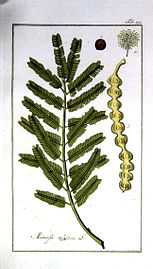Vachellia nilotica
| Vachellia nilotica but also known as Acacia nilotica | |
|---|---|
_flowers_at_Hodal_W_IMG_1163.jpg) | |
| Scientific classification | |
| Kingdom: | Plantae |
| (unranked): | Angiosperms |
| (unranked): | Eudicots |
| (unranked): | Rosids |
| Order: | Fabales |
| Family: | Fabaceae |
| Genus: | Vachellia or Acacia |
| Species: | A. nilotica |
| Binomial name | |
| Acacia nilotica (L.) P.J.H.Hurter & Mabb.[1] | |
| subspecies[2][3] | |
| |
 | |
| Range of Vachellia (Acacia) nilotica | |
| Synonyms[4] | |
Vachellia nilotica (gum arabic tree,[5] Babul/Kikar, Egyptian thorn, Sant tree, Al-sant or prickly acacia;[6][7][8] called thorn mimosa or prickly acacia in Australia; lekkerruikpeul or scented thorn in South Africa; karuvela maram in South India) is a species of Vachellia native to Africa, the Middle East and the Indian subcontinent. It is also currently an invasive species of significant concern in Australia.
This tree was originally the type species of the genus Acacia, which derives its name from ακακία (akakia), the name given by early Greek botanist-physician Pedanius Dioscorides (ca. 40–90) to this tree as a medicinal, in his book Materia Medica.[9] The renaming of the genus to Vachellia remains controversial .[10] This name derives from the Greek word for its characteristic thorns, ακις (akis, thorn).[11] The species name nilotica was given by Linnaeus from this tree's best-known range along the Nile river. The plant V. nilotica then, in turn, became the type species for the Linnaean Acacia genus (not all of which have thorns, even though they are named for them). For the ongoing reclassification of this and other species historically classified under genus Acacia, see the Acacia.
Description
Vachellia nilotica is a tree 5–20 m high with a dense spheric crown, stems and branches usually dark to black coloured, fissured bark, grey-pinkish slash, exuding a reddish low quality gum. The tree has thin, straight, light, grey spines in axillary pairs, usually in 3 to 12 pairs, 5 to 7.5 cm (3 in) long in young trees, mature trees commonly without thorns. The leaves are bipinnate, with 3–6 pairs of pinnulae and 10–30 pairs of leaflets each, tomentose, rachis with a gland at the bottom of the last pair of pinnulae. Flowers in globulous heads 1.2–1.5 cm in diameter of a bright golden-yellow color, set up either axillary or whorly on peduncles 2–3 cm long located at the end of the branches. Pods are strongly constricted, hairy, white-grey, thick and softly tomentose. Its seeds number approximately 8000/kg.[12]
Distribution
Vachellia nilotica is native from Egypt, across the Maghreb and Sahel, south to Mozambique and KwaZulu-Natal, South Africa, and east through Arabian Peninsula to Pakistan, India and Burma.[13] It has become widely naturalised outside its native range including Zanzibar and Australia. Vachellia nilotica is spread by livestock.[13]
Uses
Forage and fodder
In part of its range smallstock consume the pods and leaves, but elsewhere it is also very popular with cattle. Pods are used as a supplement to poultry rations in India. Dried pods are particularly sought out by animals on rangelands. In India branches are commonly lopped for fodder. Pods are best fed dry as a supplement, not as a green fodder.
Hedges
V. nilotica makes a good protective hedge because of its thorns.[14]
Lumber
The tree's wood is "very durable if water-seasoned" and its uses include tool handles and lumber for boats.[14] The wood has a density of about 1170 kg/m³.[2]
Propagation
There are 5000–16000 seeds/kg.[15]
Gallery
-

Seed pods
-

Compound leaf, seed, flower and seed pod
-

Bark structure
See also
References
- ↑ Kyalangalilwa B, Boatwright JS, Daru BH, Maurin O, van der Bank M. (2013). "Phylogenetic position and revised classification of Acacia s.l. (Fabaceae: Mimosoideae) in Africa, including new combinations in Vachellia and Senegalia.". Bot J Linn Soc 172 (4): 500–523. doi:10.1111/boj.12047.
- ↑ 2.0 2.1 Wickens, G.E. (1995). "Table 2.1.2 The timber properties of Acacia species and their uses". Role of Acacia species in the rural economy of dry Africa and the Near East. FAO Conservation Guide 27. Food and Agriculture Organization of the United Nations. ISBN 92-5-103651-9.
- ↑ USDA, ARS, National Genetic Resources Program. "Acacia nilotica". USDA Germplasm Resources Information Network (GRIN).
- ↑ ILDIS LegumeWeb "Acacia nilotica". LegumeWeb. International Legume Database & Information Service.
- ↑ "Vachellia nilotica (as Acacia nilotica (L.) Willd. ex Delile)". Integrated Taxonomic Information System.
- ↑ Babul dictionary_infoplease
- ↑ Babul_Mirriam Webster
- ↑ AgroForestryTree Database_World AgroForestry Centre
- ↑ "Acacia nilotica (acacia)". Plants & Fungi. Royal Botanic Gardens, Kew. Archived from the original on 12 January 2010. Retrieved 2010-01-28.
- ↑
- ↑ Quattrocchi, Umberto (2000). CRC World Dictionary of Plant Names. 1 A-C. CRC Press. p. 6. ISBN 978-0-8493-2675-2.
- ↑ Handbook on Seeds of Dry-zone Acacias FAO
- ↑ 13.0 13.1 "Prickly acacia – Acacia nilotica" (PDF). Weed Management Guide. Weeds of National Significance. 2003. ISBN 1-920932-14-3.
- ↑ 14.0 14.1 Mueller, Ferdinand (1884). "acacia+longifolia"+uses "Acacia longifolia, Willdenow". Select extra-tropical plants readily eligible for industrial culture or naturalization. G.S. Davis. p. 7.
- ↑ "Vachellia nilotica (as Acacia nilotica)". Tropical Forages.
| Wikimedia Commons has media related to Vachellia nilotica. |
| Wikispecies has information related to: Vachellia nilotica |
External links
- Carter, J.O. (1998). "7.2 Acacia nilotica: a Tree Legume out of Control". In Gutteridge, Ross C.; Shelton, H. Max. Forage Tree Legumes in Tropical Agriculture. The Tropical Grassland Society of Australia. ISBN 0-9585677-1-9.
- "Vachellia nilotica (as Acacia nilotica subsp. indica (Benth.) Brenan)". FloraBase the West Australian Flora.
- Vachellia nilotica (as Acacia nilotica) (www.frienvis.nic.in)
| ||||||||||||||||||||||||||||||||||
_flowers_at_Hodal_W_IMG_1248.jpg)
_trunk_at_Hodal_W_IMG_1252.jpg)